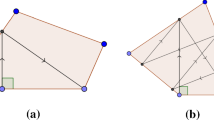Abstract
We develop a framework for dealing with smooth approximations to billiards with corners in the two-dimensional setting. Let a polygonal trajectory in a billiard start and end up at the same billiard's corner point. We prove that smooth Hamiltonian flows which limit to this billiard have a nearby periodic orbit if and only if the polygon angles at the corner are “acceptable.” The criterion for a corner polygon to be acceptable depends on the smooth potential behavior at the corners, which is expressed in terms of a scattering function. We define such an asymptotic scattering function and prove the existence of it, explain how can it be calculated and predict some of its properties. In particular, we show that it is non-monotone for some potentials in some phase space regions. We prove that when the smooth system has a limiting periodic orbit it is hyperbolic provided the scattering function is not extremal there. We then prove that if the scattering function is extremal, the smooth system has elliptic periodic orbits limiting to the corner polygon, and, furthermore, that the return map near these periodic orbits is conjugate to a small perturbation of the Hénon map and therefore has elliptic islands. We find from the scaling that the island size is typically algebraic in the smoothing parameter and exponentially small in the number of reflections of the polygon orbit.
Similar content being viewed by others
REFERENCES
L. A. Bunimovich, Ya. G. Sinai, and N. I. Chernov, Markov partitions for two-dimensional hyperbolic billiards, Russian Math. Surveys 45:105-152 (1990); Translation of Uspekhi Mat. Nauk 45, 3(273), 97-134, 221.
V. J. Donnay, Elliptic islands in generalized Sinai billiards, Ergodic Theory Dynam. Systems 16:975-1010 (1996).
V. J. Donnay, Non-ergodicity of two particles interacting via a smooth potential, J. Stat. Phys. 96:1021-1048 (1999).
P. Duarte, Plenty of elliptic islands for the standard family of area preserving maps, Ann. Inst. H. Poincaré Anal. Non Linéaire 11:359-409 (1994).
P. Gaspard and S. A. Rice, Scattering from a classically chaotic repellor, J. Chem. Phys. 4:2225-2241 (1989).
E. Gutkin, Integrable Hamiltonians with exponential potential, Phys. D 16:398-404 (1985).
E. Gutkin, Continuity of the scattering data for particles on the line with directed repulsive interactions, J. Math. Phys. 28:351-359 (1987).
K. T. Hansen, Bifurcations and complete chaos for the diamagnetic kepler problem, Phys. Rev. E 51:1838-1844 (1995).
A. Kaplan, N. Friedman, M. Andersen, and N. Davidson, Observation of islands of stability in soft wall atom-optics billiards, Phys. Rev. Lett. 87:274101-1-4 (2001).
Anatole Katok, Jean-Marie Strelcyn, F. Ledrappier, and F. Przytycki, Invariant Manifolds, Entropy and Billiards; Smooth Maps with Singularities (Springer-Verlag, Berlin, 1986).
V. V. Kozlov and D. V. Treshchëv, Polynomial integrals of Hamiltonian systems with exponential interaction, Izv. Akad. Nauk SSSR Ser. Mat. 53:537-556,671 (1989).
V. V. Kozlov and D. V. Treshchëv, Billiards, Translations of Mathematical Monographs, Vol. 89 (American Mathematical Society, Providence, RI).
W. M. Oliva and M. S. A. C. Castilla, A class of C∞-integrable Hamiltonian systems, Proc. Roy. Soc. Edinburgh 113:293-314 (1989).
V. Rom-Kedar and D. Turaev, Big islands in dispersing billiard-like potentials, Phys. D 130:187-210 (1999).
N. Simányi, The complete hyperbolicity of cylindric billiards, Ergodic Theory Dynam. Systems 22:281-302 (2002).
Ya. G. Sinai, On the foundations of the ergodic hypothesis for dynamical system of statistical mechanics Dokl. Akad. Nauk. SSSR 153:1261-1264 (1963).
Ya. G. Sinai, Dynamical systems with elastic reflections: Ergodic properties of scattering billiards, Russian Math. Surveys 25:137-189 (1970).
U. Smilansky, Semiclassical Quantization of Chaotic Billiards—a Scattering Approach, Proceedings of the 1994 Les-Houches summer school on “Mesoscopic quantum Physics,” A. Akkermans, G. Montambaux, and J. L. Pichard, eds. (1995).
D. Szász, Boltzmann's ergodic hypothesis, a conjecture for centuries?, Studia Sci. Math. Hungar. 31:299-322 (1996).
D. Turaev and V. Rom-Kedar, Islands appearing in near-ergodic flows, Nonlinearity 11:575-600 (1998).
M. Wojtkowski, Principles for the design of billiards with nonvanishing Lyapunov exponents, Comm. Math. Phys. 105:391-414 (1986).
H. Yoshida, A. Ramani, B. Grammaticos, and J. Hietarinta, On the non-integrability of some generalized Toda lattices, Phys. A 144:310-321 (1987).
S. L. Ziglin, Branching of solutions and non-existence of first integrals in Hamiltonian mechanics, i, II., Funct. Anal. Appl. 16 and 17:181-189, 6-16 (1982, 1983).
Author information
Authors and Affiliations
Rights and permissions
About this article
Cite this article
Turaev, D., Rom-Kedar, V. Soft Billiards with Corners. Journal of Statistical Physics 112, 765–813 (2003). https://doi.org/10.1023/A:1023884227180
Issue Date:
DOI: https://doi.org/10.1023/A:1023884227180



